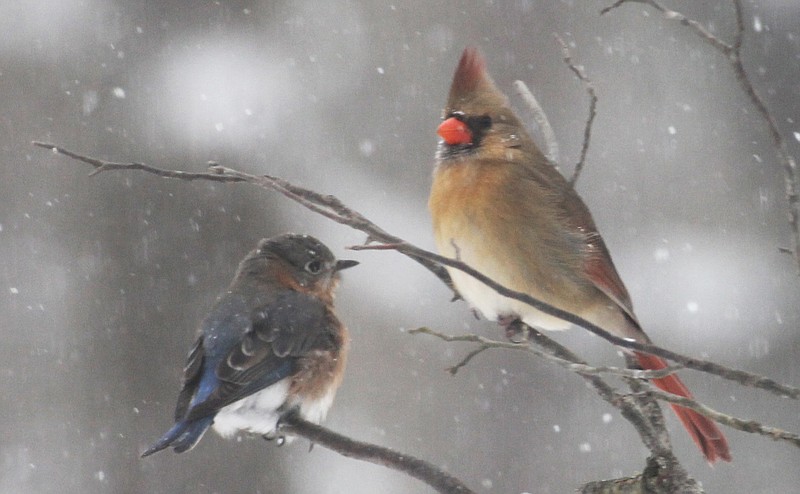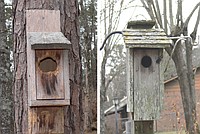When Thomas Jefferson was president of the United States, a young emigrant from France went ice skating on the Perquiman River near Philadelphia. In his carelessness, he fell through a patch of thin ice and was trapped in the frigid water between the gravel bottom and the icy surface.
The current swept him downstream about 40 yards. He most certainly would have perished had it not been for the fact that a tundra swan had been continuously swimming in a single spot, stirring the water so it didn't freeze and ensuring the swan could drink. Tumbling beneath the ice, the man arrived where the swan was keeping the ice from freezing. He was able to pop above it and pull himself to safety with the aid of his companions.
That young man was none other than John James Audubon, the foremost painter of American birds and a champion of bird lovers world over.
There are no tundra swans on the Perquiman today. But in Arkansas, during nine days of extreme low temperatures and a record snowfall in February, birds in our yards, parks and woodlands were in peril. Many of these birds died. Just as the swan played a role in the rescue of Audubon, humans can play a role in the continued well being of birds.
SOUNDING AN ALARM
Some people in Arkansas have a "fowl" obsession. That obsession leads them to their computers and phones where they connect through the internet to text about birds over the listserv ARBird-L.
Before the storm, ARBird discussion centered on the abundance of migrating robins, but as temperatures plunged, posts emerged about robins dying on porches and beneath shrubs. Near Toltec Mounds State Park in Lonoke County, an electrician counted 20 dead robins on his porches and in his yard and dead starlings near his barn. His neighbors had similar numbers of dead robins. Dead robins were also reported at the University of Arkansas, Fayetteville, and along Bathhouse Row in Hot Springs.
For birds, the cold weather was a "kick in the ice."
Most who weigh in on ARBird are self-educated enthusiasts but others are university professors of biology, wildlife officers and environmental scientists. Others don't have that education. In general, the consensus discussion after the storm was that lack of drinking water contributes to bird deaths when ice is everywhere.
Jerry Davis, a retired wildlife biologist of the U.S. Forest Service, has observed that birds can make their own water by eating snow. While this process works well for species of birds from more northerly climates, Southern birds do not appear to be well adapted to it. Eating snow for water requires many more calories than drinking the liquid form.
Davis has several water features around his home, and he feeds birds hundreds of pounds of seeds each winter. Though most of his water features for birds froze during the deep cold, one shallow pool 3 feet wide is heated. Birds flocked to it mid-February. He found no dead birds in the nesting boxes around his home. Davis did find a dead goldfinch in his driveway when the snow dissipated.
[RELATED: Bluebirds died in bluebird boxes]
He adds that he has only native fruit-bearing plants in his yard and allows grass and weeds to grow tall instead of mowing; and he does not remove dead trees and snags.
In an unscientific investigation of the impact of available drinking water on the mortality of birds, I went to downtown Hot Springs and visited the area where thermal water oozes from the earth at about 130 degrees. From there it trickles down the mountainside and collects in a pool that gives off a bit of warmth and in the cold air makes steam. It is a place where I frequently go to look at birds. In January, I observed robins gorging on yaupon holly berries there.
On this visit, most snow was gone but patches remained. In 20 minutes, I saw only one mockingbird, one pigeon (high atop a nearby building), and I heard a singing Carolina wren. Overall, there was far less bird activity than I am accustomed to seeing. The holly berries were gone.
Four maintenance workers had been busy there for a few hours, raking and blowing leaves and loading them by hand into a truck. I asked them one by one whether they had found any dead birds. None had, though all four reported that three days earlier doing similar work they had found dead birds farther south along Bathhouse Row, away from the thermal springs. One man reported four dead robins; one reported two dead robins; one reported two birds that he said were some kind of blackbird; the fourth man reported finding a smaller bird with a yellow breast that he could not identify. From his description it may have been a goldfinch.
My nonscientific conclusions:
1) Bird mortality in that area was lower than in areas farther away.
2) Robins seemed to die at higher rates than other species, though they were not the only species hurt.
3) The total number of all species of birds being seen is reduced.
THE CIRCLE OF LIFE
As the sun was going down on the last day the snow covered our world, I looked out my kitchen window. There I saw a tiny dead Carolina chickadee atop the snow. The next morning, as icicles began to drip and snow began to melt, I went outdoors to get a closer look at the chickadee. It was not there.
The tracks of a small red fox were there instead. The fox left not a feather behind.
It is the natural order of things for certain segments of wild creatures to diminish or flourish during extreme weather. Though the songbirds suffered sorely through the blizzard, crows, vultures, certain hawks and perhaps other birds of prey and wildlife like the fox are benefiting from carrion and weakened birds.
In that sense, a dead bird is as much part of nature as is a live one.
NATURAL DEFENSES
It is not as though songbirds were utterly defenseless in cold weather. A few ARBird posts made note of these defenses.
◼️ Some birds fatten up in advance of winter — if they can find protein-rich insects, which isn't so likely where pesticides are in widespread use.
◼️ Birds with metabolisms that can't build reserves — such as robins — migrate to places where conditions are more conducive to life. Inconveniently, the timing, severity and duration of this storm resulted in their migrating at an unfortunate time.
◼️ The heavy snow, while it covered the ground where birds might forage, also hung on the leaves of bushes and low trees in way that created little "igloos" where birds could huddle out of the wind.
◼️ Bird feathers are an excellent natural insulating material. When a bird puffs itself up into a ball, those feathers trap air and hold moisture away from its body.
◼️ Birds roost and sleep together in dense vegetation like cedar trees, nesting boxes or the cavities of trees, sharing the warmth of one another just as humans are taught to do in survival training.
◼️ Some birds (particularly chickadees, titmice and some woodpeckers) store food in crevices and beneath tree bark for a snowy day. But if a thick glaze of ice covers the trees as it did in some places in this storm, it closes the door on these storehouses.
A small, marginally healthy songbird cannot be expected to live more than 36 hours without taking at least some nourishment while eating snow for hydration.
Donald Steinkraus, professor of entomology at the University of Arkansas, Fayetteville, suggested that planting as many native berry-producing shrubs and trees as possible would be a big help to birds, as would leaving native grasses and prairie plants tall and full of seeds instead of mowing or burning.
WHEN THE SNOW GOES
As the snow days stretched on, many on ARBird grew restless in their homes. The dismal discussion of the plight of birds grew tiresome. One regular contributor posted, "I don't mean to offend, but can we stop talking about dead birds now. The tragedy is over and it's time to move forward."
Steinkraus replied: "As a scientist, a biologist, an entomologist, I am interested in mortality in animal populations. While I admit it is painful and sad to learn about mortality, understanding the impact of environmental factors on bird populations is extremely important ... Bird populations, overall, are declining, as are freshwater fish, mussels, and insect populations.
"It is essential that we discover the causes of declines in bird, insect, plant, fish, mussel populations, and work to reverse these declines. In order to do that we need estimates of what happened during this extreme cold weather ... What bird species were killed, how many, and why, and what we can do to mitigate such events in the future?"
He asked people to continue to document and report to him the species and numbers of dead birds and what they think happened. "From my observations in Fayetteville," he wrote, "robins and mockingbirds were hit hardest." And he observed that the dead birds at the university were soon eaten by crows and other animals.
"Documenting the numbers of birds and the species is a form of citizen science," he wrote.
Anyone can subscribe to the ARBird listserv for free. Information about joining the list is at arbirds.org/arbirds_discussion.html.
Jerry Butler writes frequently about Arkansas birds and the people who enjoy them. Share your stories with him at
jerrysharon.butler@gmail.com
Photo Gallery
Birds in the snow
Photographers David Seals and Jerry Butler documented suffering of birds in their neighborhoods at Hot Springs during the February snowstorms.

